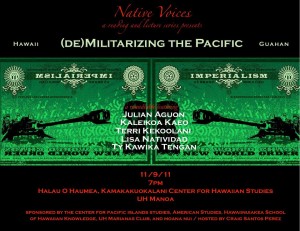Send in the Choppers?
Here’s a report from recent hearings for proposed Marine Corps helicopter expansion plans that were held on Hawai’i island:
http://bigislandweekly.com/news/send-in-the-choppers.html
Send in the Choppers?
Tuesday, December 6th, 2011
Marines unveil EIS for more helicopters here.
By Alan D. McNarie
The Marines were back in town last week, holding meetings in Waimea and Hilo to get public input on a plan to base three more squadrons of attack aircraft in the islands and train them at areas including Hawai’i Island’s Pohakuloa Training Area. As usual, they got an earful from Native Hawaiians, peace activists and concerned citizens. But they also got support from a few parents of past and former military personnel, who wanted the Corps to provide its personnel with the best training possible.
The plan would bring up to two Marine Medium Tiltrotor (VMM) squadrons and one Marine Light Attack Helicopter (HMLA) squadron to the islands, where they would be based on O’ahu and train there and on other islands. The VMM squadrons would bring with them a total 24 MV-22 Osprey tiltrotor aircraft, which take off and land vertically like helicopters and fly like airplanes; a relatively recent and controversial addition to the Marine Corps Arsenal, they replace large troop-transport helicopters and have superior range and speed, but bring with them a troubled reputation for crashes, malfunctions, delays and cost overruns during their development. But when one resident brought up a troubling report about the aircraft’s performance, a Marine spokesman said those problems had largely been solved by improved parts and supply.
“Every mission that we’ve been asked to do with the V22, we have been able to do.”
The HMLA squadron is armed with 15 AH-1 Cobra attack helicopters and 12 UH-1 Huey utility choppers. Hueys and Cobras have been flying with the Marines since Vietnam, but the airframes have gone through a series of updates, and the Marines are planning to replace neither with a radically different vehicle in the near future. A helicopter pilot who accompanied the Marine Team at Hilo told Big Island Weekly that while the new AH-1Z version of the Cobra has better range, performance and electronics than the current choppers, its logistics and personnel needs would be about the same.
Coming along with the aircraft would be approximately 1,000 active-duty military personnel, 22 civilian personnel (contractors and government employees), and 1,106 civilian dependents, mostly stationed on O’ahu.
On the Big Island, most of the impacts of the new squadrons would be felt, literally, at Pohakuloa. The squadrons will be using the firing range and various landing sites there, and “New construction or improvements to existing landing zones and other facilities” are expected to occur. Marine officials assured BIW that the landing sites they had identified for use in training were within PTA itself. One map on exhibit at the meetings showed possible landing zones marked in red within the training area, but also showed five landing zones, including Mauna Kea State Park, marked in black outside the PTA boundaries. Marine officials told BIW that those sites were on the map for “reference” only.
[…]
Residents expressed concerns that powdered DU, which has been linked to cancer and other ailments, could be kicked up by continued use of the Pohakuloa firing range and drift to residential areas and Waikoloa Elementary School.
“Less than one percent of the base has been surveyed, so how do you know that you’re not going to be impacting DU?” pointed out Albertini. “To say that this is outside the scope of this EIS is bogus, because you don’t know where the DU is.”
One resident wondered if DU and other heavy metals from the firing range could also get into the local groundwater supply, and noted that that the possible effects of Pohakuloa activities on groundwater were not addressed in the EIS.
In response, a Marine official admitted that “”there has never been an investigation,” of the aquifer under Pohakuloa, though the Army has gotten funding to sink two test wells.
“Nobody knows where that water is,” he said. “We will, know, probably, by 2012.”
The EIS itself raised some concerns about impacts on historic and cultural sites, though most of the ones identified were on O’ahu. The document identified no pre-contact cultural sites on the Big Island and only two historic ones: the fence wall from ranching days and “the old Kona to Waimea Government Road.” PTA has an ongoing program to protect known cultural sites. But Native Hawaiians have long complained that most of the PTA firing range has never been surveyed. At the Hilo meeting, one resident cited the lament of a Native Hawaiian who complained that he’d repeatedly been denied permission to collect “the bones of his ancestors,” which were lying exposed on the range and had been broken into smaller and smaller pieces over the years.









